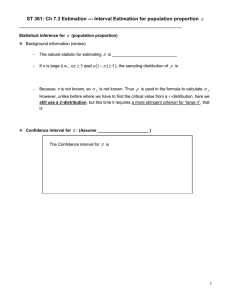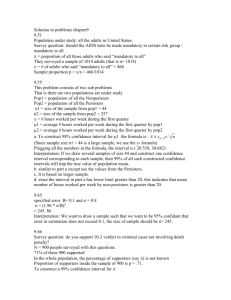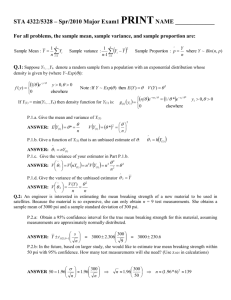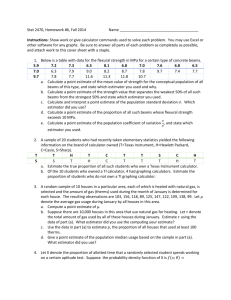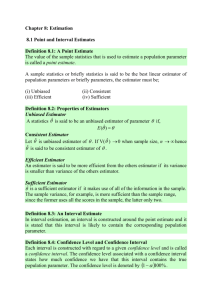Chapter 7.3: Estimation - Interval Estimation for
advertisement
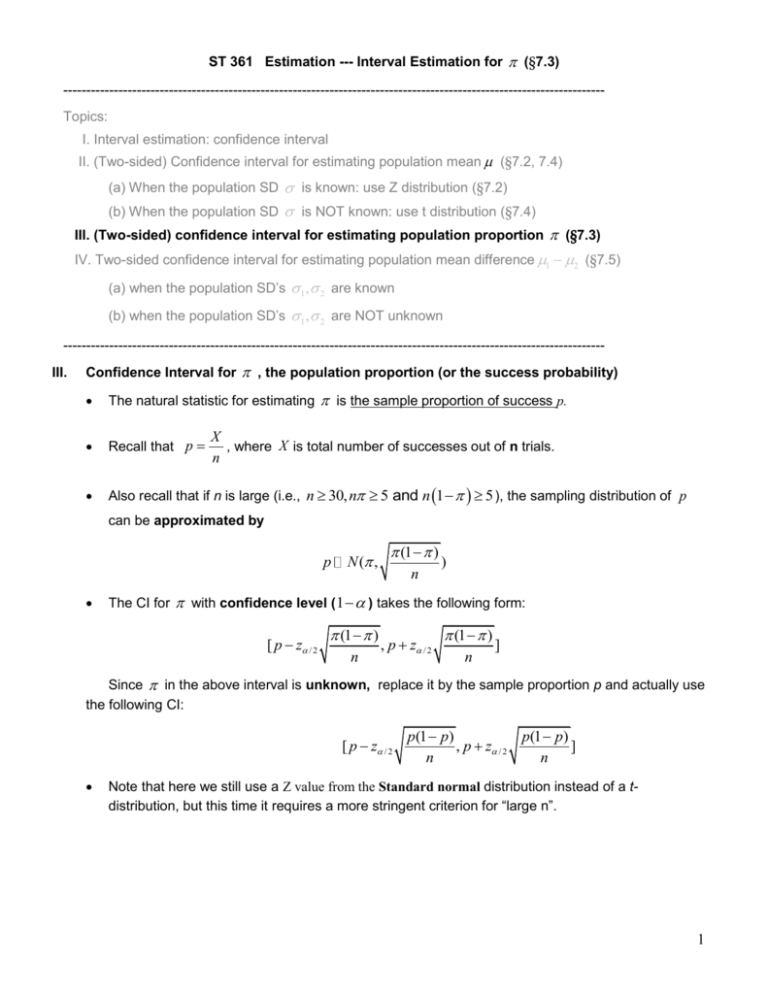
ST 361 Estimation --- Interval Estimation for (§7.3) ---------------------------------------------------------------------------------------------------------------------Topics: I. Interval estimation: confidence interval II. (Two-sided) Confidence interval for estimating population mean (§7.2, 7.4) (a) When the population SD is known: use Z distribution (§7.2) (b) When the population SD is NOT known: use t distribution (§7.4) III. (Two-sided) confidence interval for estimating population proportion (§7.3) IV. Two-sided confidence interval for estimating population mean difference 1 2 (§7.5) (a) when the population SD’s 1 , 2 are known (b) when the population SD’s 1 , 2 are NOT unknown ---------------------------------------------------------------------------------------------------------------------III. Confidence Interval for , the population proportion (or the success probability) The natural statistic for estimating is the sample proportion of success p. Recall that p Also recall that if n is large (i.e., n 30, n 5 and n 1 5 ), the sampling distribution of p X , where X is total number of successes out of n trials. n can be approximated by p N ( , (1 ) n ) The CI for with confidence level ( 1 ) takes the following form: [ p z / 2 (1 ) n , p z / 2 (1 ) n ] Since in the above interval is unknown, replace it by the sample proportion p and actually use the following CI: [ p z / 2 p(1 p) p(1 p) , p z / 2 ] n n Note that here we still use a Z value from the Standard normal distribution instead of a tdistribution, but this time it requires a more stringent criterion for “large n”. 1 In conclusion, Still use Z-distribution to find the critical value z* Need np > 10 and n(1-p)>10 for p to be normally distributed. Confidence interval for : (Assume n>30, np > 10 and n(1-p)>10) The Confidence interval for is [ p z / 2 p(1 p) p(1 p) , p z / 2 ] n n Ex1. For a certain disease, there is a generic drug and a brand name. We want to estimate = P(the brand name is more preferred by a patient). So 100 patients were asked, and 20 of them preferred the brand name. (a) What is your estimate of ? What is the estimated SE of your estimator? Answer: A natural estimator of is the sample proportion p = 20/100=0.2. The estimated standard error (SE) of p is p(1 p) 0.2 (1 0.2) 0.04 n 100 (b) Find the 95% CI for Answer: Here n = 100>30, np = 100*0.2=20>10, n(1-p)=100*0.8=80>10. So we can use the CI formula for given above. 1 0.95, 0.05, / 2 0.025, z0.025 1.96. So a 95% CI for is [ p z / 2 p(1 p) p(1 p) , p z / 2 ] =[0.2 - 1.96*0.04, 0.2+1.96*0.04]=[0.122,0.278]. n n (c) What is the width of your CI? Answer: The width of the CI is 0.278 – 0.122=0.156. (d) If we want to make the width of our 95%CI for be 0.1, how many patients should be sampled? Answer: The width of our 95% CI is 2 z / 2 p(1 p) p(1 p) 2 1.96 0.1 n n 2 0.2 0.8 2 1.96 0.1, n 0.2 0.8 246. n 0.1 2 If we use p=0.2, then 2 1.96 If we treat p unknown (it is unknown before the sampling), we can use p=0.5 in the formula and 0.5 0.5 2 1.96 0.1, n 0.5 0.5 384. n 0.1 2 solve 2 1.96 Ex2. Suppose that the proportion of the left-handed students at a certain university is . A random sample of 200 students was collected and found that 40 out of the 200 students are left-handed. (a) Use an unbiased estimator to compute a point estimate of . Answer: an unbiased estimator of is the sample proportion p =40/200=0.2 (b) What is the approximate distribution of your estimator in (a)? Why? Answer: It can be well approximated by a normal distribution since n=200>30, np=40>10 and n(1-p)=160>10. (c) What is the estimated standard error of your estimator? (Hint: if the population proportion is known, then p 1 n ) Answer: The estimated standard error of p is p(1 p) 0.2 0.8 0.028 n 200 (d) Your estimator in (a) is unbiased because (circle one) i. Its distribution is normal ii. Its mean is equal to iii. Its SE is equal to 1 n iv. It is based on a sample with size greater than 30 (e) What is a 95% confidence interval for ? Answer: since n=200>30, np=40>10 and n(1-p)=160>10, we can use the formula given before: [ p z / 2 p(1 p) p(1 p) , p z / 2 ] [0.2 1.96 0.028,0.2 1.96 0.028] [0.145, 0.255] n n 3
